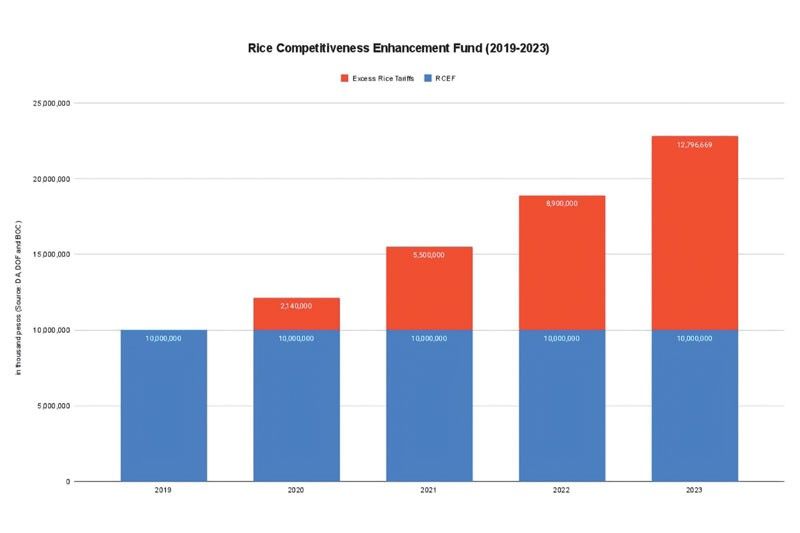Special report: Rice fund raises stakes for farmers

(First of three parts)
Five years ago, lawmakers and government officials made a promise of a lifetime: the country’s rice farmers would be competitive at long last.
That promise was embodied in four letters: RCEF, short for Rice Competitiveness Enhancement Fund.
The fund was created by the landmark Republic Act 11203 or the Rice Tariffication Law, which took effect on March 5, 2019 and which liberalized the country’s rice trade regime.
To help Filipino rice farmers compete against the free entry of imported rice, RCEF was born.
The six-year fund – set to end this year – had one goal: make farmers competitive. How? Through the provision of at least P10 billion worth of support in the form of seeds, machines, credit and extension work.
Fast forward to today, lawmakers and government officials are making another promise: extend the life of the fund to make the farmers competitive – at long last?
Pushing for extension
A week before RA 11203 turned five last Feb. 14, Sen. Cynthia Villar, the principal author of the law, made a momentous remark.
“I am sponsoring the Rice Tariffication Law extension bill,” Villar told the staff of the Philippine Rice Research Institute in Nueva Ecija, the country’s rice granary.
Villar said extending RCEF is necessary to reach the government’s goal of a national average palay yield of six metric tons per hectare. She said the current average yield remains below five MT per hectare.
RCEF was envisioned to raise farmers’ income by 30 percent by improving their yield, slashing production costs and reducing post-harvest losses.
“You have to renew (RCEF) for another five years because we have not yet achieved what we wanted to achieve,” Villar said in a separate interview with reporters recently.
The goal is also to bring down production cost of palay to P6 per kilogram, which she noted remains far from reality, she said.
Nonetheless, Villar lauded the improvements that the RCEF, particularly its seed component, has made to local palay productivity.
The latest average yield figures of RCEF seed beneficiaries have reached 4.36 metric tons per hectare as of dry season 2023, from benchmark 3.63 metric tons in 2019, according to the Philippine Rice Research Institute.
Villar said she has already asked the implementing agencies of the RCEF components to prepare their reports, particularly achievements, to justify the extension of the program.
Obligation versus actual disbursement
Government documents obtained by The STAR showed that implementing agencies of the RCEF have obligated 95.33 percent or about P47.667 billion out of its P50 billion total fund in the past five years at the end of 2023.
However, the disbursement rate has been quite lackluster at just 74 percent or P35.259 billion.
All four RCEF components -- seeds, machines, credit and extension work -- posted an above 95 percent obligation rate but it is in the disbursement when things get different.
Only two components recorded a disbursement rate higher than 90 percent: seeds at 93.08 percent and credit at 98.09 percent.
The extension component had an 82 percent disbursement rate while the mechanization was the laggard at just 55.98 percent.
Achievements so far
Despite the low disbursement rate, the mechanization component reached a 91.03 percent accomplishment rate in terms of its achievement at the end of last year.
This translated to 25,519 mechanization technologies delivered out of the 27,910 technologies procured in the past five years.
The technologies included hand tractors, four-wheel tractors, seeders, transplanters, combine harvesters, reapers, dryers and rice mills.
The RCEF seed component, meanwhile, has distributed 15.11 million 20-kilogram bags of inbred rice seeds to 6.084 million beneficiaries. The component achieved a 92 percent accomplishment rate out of its target of 16.352 million bags.
The distributed inbred rice seeds have been planted to nearly seven million hectares of land since 2019.
For the extension component, the government achieved 94 percent of its target number of trainings or about 10,651 out of the targeted 11,329 batches. About 251,971 benefited from the RCEF training.
The state has extended P4.625 billion in combined loans to 14,862 individuals and 309 farmers cooperatives and associations (FCAs) under the credit assistance component of RCEF. Broken down, P3.302 billion went to FCAs while P1.322 billion were lent to individuals.
Of the total loans granted during the five-year period, P2.15 billion were from the Development Bank of the Philippines while P2.448 billion came from the Land Bank of the Philippines.
Yearning for legislation
At present, there are two bills filed at the House of the Representatives that seek to extend the RCEF program.
First is House Bill (HB) 212 filed by father-daughter lawmakers Sultan Kudarat Rep. Horacio Suansing Jr. and Nueva Ecija Rep. Mikaela Angela Suansing last 2022.
The bill seeks to institutionalize the RCEF program and allocate all rice tariff collections into it in perpetuity.
The bill also wants to hike the RCEF by P5 billion to P15 billion, to be allocated for the provision of fertilizer and other chemical inputs.
Meanwhile, the bill proposes to reduce the fund for the credit assistance program by P500 million due to its underperformance then. The amount would then be transferred to the mechanization component, making it P5.5 billion.
The bill noted that its proposed amendments were based on the master’s thesis of the younger Suansing, who earned her degree from Harvard University, that focused on improving the RCEF implementation.
The second bill - HB 9547 - filed by Rosanna Vergara, another Nueva Ecija representative, last Nov. 2023 seeks to extend RCEF by another six years.
There is currently no counterpart bill filed at the Senate for the extension of RCEF.
Agriculture experts and stakeholders interviewed by The STAR reached a consensus:
RCEF must continue and it must change to realize its goal of making Filipino farmers competitive.
And topping the list of changes they proposed? Revisit RCEF’s “rigid” allocation.
To be continued
- Latest
- Trending


























